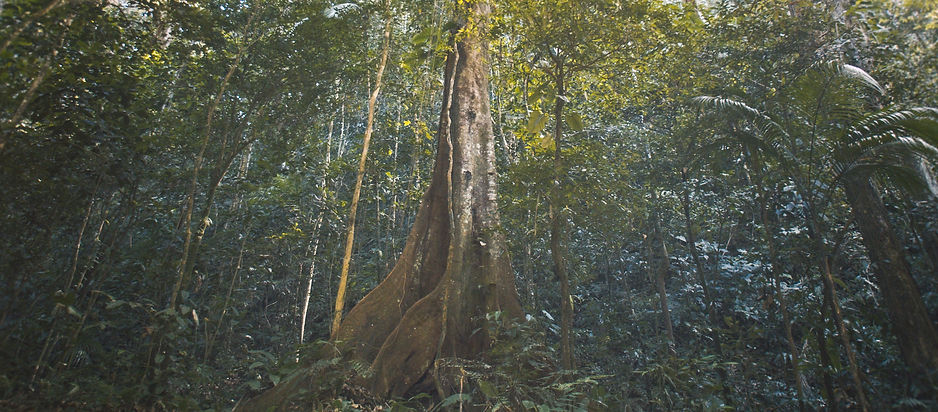
A cinematic journey deep into the tropical rain forest exploring its enormous biodiversity and reflecting on the natural life cycle.

About
After a poetic introduction by the Indigenous community leader, we set off on a cinematic journey deep into the heart
of the Atlantic Forest. We enter a mysterious world and explore the richness of its forms of life.
We are in one of the most biodiverse places on our planet.
As a camera moves slowly through the dense vegetation, we stumble upon our protagonists - a three-toed sloth,
a group of black lion tamarins, potoo, and leaf-cutting ants. We are moving in circles, returning to the places
we have already visited and discovering new ones, and meeting our protagonists again to witness their
ordinary lives in the wild.
Our journey begins at daybreak and continues until dusk, throughout the night until the end, on the misty morning the next day. Introducing time-lapse sequences we bend this simple one-day time-axis, so our journey turns into a metaphor for
the perpetual natural cycle, where growth and birth, occur interchangeably with death and decay. The film structure is going to reflect some of the elements of the forest life cycle. The film structure reflects some elements of the life cycle of the forest and its inhabitants - wake up, growth, foraging, moving around, resting, blossom, threat, death, decay, maternity, nightlife.
This fascinating world with its everlasting natural processes is a very vulnerable place. The fast-progressing pressure of human civilisation with its demand for more space for agriculture, industry, and settlements poses a serious threat to
the last remaining swaths of this unique biome.
genre: documentary
planned duration: 70 min
format: 4K
production status: post-production (roughcut)
planed completion: 2025
Protagonists

Brown-throated sloth (B. variegatus)
famously slow-moving herbivorous mammal spends most of its life in the canopies feeding on leafs, especially of its favourite Cecropia tree. They have three long claws on each limb that help them to climb the trees.

Black lion tamarin (Leontopithecus chrysopygus)
endemic to the Atlantic Forest, one of the rarest of the Neotropical monkeys, until recently considered to be extinct. Usually found in groups up to 9 individuals. They spend long periods each day searching for different types of insects and spiders to feed on, looking under dry palm leaves, in loose bark, and in tree cavities, with hands that have specialized fingers for prying. Although fruit, gum, leaves are important elements of their diet too. They communicate using low-pitched calls to defend territory, maintain cohesion within the group, attract a mate, and contact individuals who might be lost.

Leaf-cutter ants (Atta sp.)
can carry twenty times their body weight and cut and process fresh vegetation (leaves, flowers, and grasses) to serve as the nutritional substrate for their fungal cultivates. Next to humans, leaf-cutter ants form some of the largest and most complex animal societies on Earth.

Chestnut-bellied euphonia (Euphonia pectoralis)
tiny bird endemic to the Atlantic Forest, found in the canopy of humid forests and forest borders; often accompanying mixed-species flocks.

Common potoo (Nyctibius griseus)
a nocturnal bird that spends daytime motionless mimicking the tree trunk on which it rests, using a technique called masquerading.

The Atlantic Forest
The tropical rain forest that stretches from northeast Brazil, south along the Brazilian Atlantic coastline and inland into northeast Argentina and eastern Paraguay.
The Atlantic Forest harbours a range of biological diversity similar to that of the Amazon although today more than 85% of this forest has been cleared and what remains is highly fragmented.
The Atlantic Forest is inhabited by around 2,200 species of birds, mammals, reptiles and amphibians—5% of the vertebrates on Earth. This includes nearly 200 bird species found nowhere else.
The Atlantic Forest is also home to around 20,000 species of plants, representing 8% of the Earth’s plants
New species of flora and fauna continue to be discovered.
Creative team

Michał Białożej - producer, script, director, cinematography
Filmmaker, producer and environmental biologist with background in film production. Worked on a number of documentaries, feature films and short forms like commercials and music videos. Since he fell in love with Neotropical wildlife and in particular with the Atlantic Forest he attempts to share that fascination with others in the form of a documentary ‘Through the Atlantic Forest’.

Kamil Dobrosielski - aerial photography, editing
A Golden Trailer Award nominee, who worked as an editor on a number of fiction shorts. Most recently he has co-edited ‘Napoli 1990, Napoli 2023’, a documentary by Nico Marzano.
Kamil’s also produced short docs for BBC Reel and edited numerous trailers for the ICA London; an independent distributor of arthouse films in the UK and Ireland.
Currently Kamil is developing ‘Sandro’, his feature documentary debut about an aspiring rapper/activist from Medellin, Colombia.